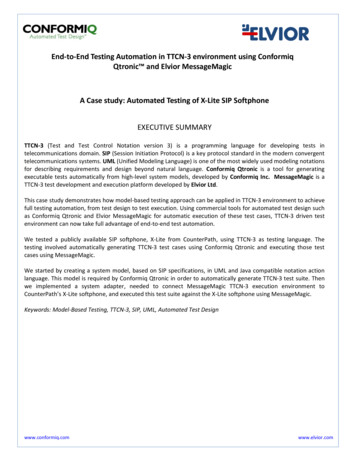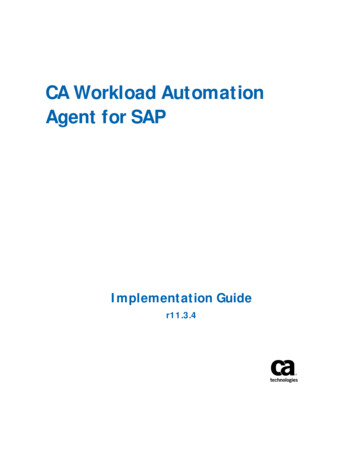
Transcription
End-to-End Testing Automation in TTCN-3 environment using ConformiqQtronic and Elvior MessageMagicA Case study: Automated Testing of X-Lite SIP SoftphoneEXECUTIVE SUMMARYTTCN-3 (Test and Test Control Notation version 3) is a programming language for developing tests intelecommunications domain. SIP (Session Initiation Protocol) is a key protocol standard in the modern convergenttelecommunications systems. UML (Unified Modeling Language) is one of the most widely used modeling notationsfor describing requirements and design beyond natural language. Conformiq Qtronic is a tool for generatingexecutable tests automatically from high-level system models, developed by Conformiq Inc. MessageMagic is aTTCN-3 test development and execution platform developed by Elvior Ltd.This case study demonstrates how model-based testing approach can be applied in TTCN-3 environment to achievefull testing automation, from test design to test execution. Using commercial tools for automated test design suchas Conformiq Qtronic and Elvior MessageMagic for automatic execution of these test cases, TTCN-3 driven testenvironment can now take full advantage of end-to-end test automation.We tested a publicly available SIP softphone, X-Lite from CounterPath, using TTCN-3 as testing language. Thetesting involved automatically generating TTCN-3 test cases using Conformiq Qtronic and executing those testcases using MessageMagic.We started by creating a system model, based on SIP specifications, in UML and Java compatible notation actionlanguage. This model is required by Conformiq Qtronic in order to automatically generate TTCN-3 test suite. Thenwe implemented a system adapter, needed to connect MessageMagic TTCN-3 execution environment toCounterPath’s X-Lite softphone, and executed this test suite against the X-Lite softphone using MessageMagic.Keywords: Model-Based Testing, TTCN-3, SIP, UML, Automated Test Designwww.conformiq.comwww.elvior.com
IntroductionIn this case study we explain how we tested a publicly available SIP softphone using end-to-end test automation ina TTCN-3 environment. TTCN-3 (Test and Test Control Notation version 3) is a notation for describing executabletest cases, standardized by ETSI (European Telecommunication Standards Institute). TTCN-3 is widely applied inthe telecommunications domain. Using commercial tools Conformiq Qtronic for automated test design and ElviorMessageMagic for automatic execution of these test cases, TTCN-3 driven test environment can now take fulladvantage of end-to-end automated testing process.SIP stands for Session Initiation Protocol. It is a standardized protocol (standards body IETF, the InternetEngineering Task Force) for establishing, managing and terminating media sessions and handling the necessaryinfrastructure such as registering the terminals that are available for users. It is widely used, for example, in theVoIP (Voice over Internet Protocol) and IMS (IP Multimedia Subsystem).Automated test design refers to test design automation where executable tests are automatically generated fromthe high-level system models. It extends the notion of test automation from mere test execution to also testdesign. Model-based automated test design reduces quality assurance risks and costs, because it removes possiblehuman errors from the areas of test design, test selection and test script coding. Furthermore, the models createdare test assets and shared with system designers and improve communication among designers and testers. Thisresults in improved system documentation and resulting product quality.In this case study our aim is to demonstrate how end-to-end test automation works in a TTCN-3 environment.Automated Test Generation and Execution WorkflowWe generated the tests from the SIP softphone model that presents the expected and correct behaviour of thesystem under test (SUT) from an external perspective. The test suite was generated using Conformiq Qtronic 2.0.3,which is available as an Eclipse plug-in. Conformiq Qtronic imports the system model of the SUT and generates testscripts using configurable back-ends, in the test language of choice. Here we used TTCN-3 back-end scripter togenerate test scripts in TTCN-3 format. The test scripts were executed against the SUT, CounterPath’s X-Lite SIPbased softphone (version 3.0 build 53117), using MessageMagic test execution tool.End-to-End testing automationSUT modelWe constructed the SUT model using UML 2.0 state machine and Java compatible notation action language.Conformiq Modeler, a free lightweight modelling tool from Conformiq, was used for creating the system modelUML state machine. The action language artefacts were written using a standard Eclipse Java editor. Users can useother modelling tools such as Enterprise Architect, Telelogic or IBM modelling tools for their modelling needs.www.conformiq.comwww.elvior.com
We created the model of the SUT by using the SIP standard (RFC 3261) specifications as a reference. In particular,the implementation (of X-Lite) was not consulted when creating the model. This ensured that the testing wasindependent of the implementation, which is an important aspect in conformance testingThe functional requirements of the specifications that were selected for testing in the implementation wereannotated on the model of the SUT using the keyword requirement. There were twenty one such explicitlyannotated requirements. Note that the model was built using a larger number of the requirements in the SIPspecification but not all of them were chosen as testing goals for this case study.System Model for generating test cases automaticallyGenerating the TTCN-3 Test SuiteThe set of test cases is chosen automatically by Conformiq Qtronic according to defined testing goals such asrequirements, states, and transitions coverage. A component of the model (for example, a method, a transition ora conditional branch) can be said to be covered by a test case if executing the test case against the SUT wouldguarantee that the said component of the model would be exercised during the test. Conformiq Qtronic attemptsto create a test suite that covers as many of the different model components the user has selected. This approachcreates a reasonably compact test suite that exercises a large amount of the functional features in the model.www.conformiq.comwww.elvior.com
Our goal was to generate tests that cover all annotated requirements and all states/transitions of the model. Theresulting test suite contained eleven test cases. The generated test suite covered 100% of the annotatedrequirements, states and transitions.Conformiq Qtronic provides several useful windows for analysing the generated test suites:ooooooCoverage Editor allows users to choose coverage settings. It also shows the final status of black-box coverageafter the test generation cycle.Test Case List shows all the generated test cases with the date and the name. The user can rename the testcases as required.Traceability Matrix View correlates the coverage goals such as requirements to the test cases.Test Case View shows the interaction between the tester and the system under test.Test Step View shows detailed information about the messages that are transferred between the tester andsystem under test in the given test case.Execution Trace View links the test case to the parts of the model.Conformiq Qtronic test generation and analysis environmentwww.conformiq.comwww.elvior.com
Automatically generated TTCN-3 test caseTest Execution EnvironmentArchitecture of the testing environment is shown in the figure below. MessageMagic TTCN-3 test executionenvironment was used for executing the test suites generated by Conformiq Qtronic. The system under test – XLite SIP softphone - is a Windows application. In order to connect the test execution tool to the SUT, a systemadapter was built.The system adapter mediated SIP messages between UDP transport and MessageMagic and user actions fromMessageMagic to X-Lite graphical interface using TTCN-3 standardized TRI interface (Test Runtime Interface). Thesystem adapter contains two adapters – UDP adapter and X-Lite GUI adapter. The UDP adapter is responsible fortransferring SIP messages and it is configured to map the TTCN-3 ports to the UDP ports. The X-Lite GUI adapter isdesigned for eliminating the needs for user manual intervention during the test cases execution. It simulates useractions via Windows API allowing full automation of the test case execution.www.conformiq.comwww.elvior.com
End-to-End Test Automation of X-Lite softphone in TTCN-3 EnvironmentBy the definition, here the system model is an abstracted presentation of the system from external behaviourperspective. It does not describe all the details of the system but only the essential aspects under consideration.Thus it is a golden abstract implementation of the system, excluding internal implementation details.The generated test suite in TTCN-3 represented SIP softphone behaviour corresponding to the abstraction level inthe model. A test case generated by Conformiq Qtronic is a sequence of inputs and expected outputs of abstractmessages corresponding to the abstraction level used in modelling. Conformiq Qtronic TTCN-3 script back-endmaps SUT inputs and outputs to corresponding function calls in TTCN-3. It is the responsibility of the test harness tomaintain a mapping between abstract message values generated by Conformiq Qtronic and real SIP messagevalues that are adapted to the particular test execution environment. In this case study the test harness waswritten in TTCN-3 and the system adapter carried real SIP messages.In TTCN-3 language, messages are defined as data structures. The TTCN-3 executive uses the SIP codec forencoding the data structures to SIP text messages and vice versa. MessageMagic supports two options forencoding SIP messages: built-in text codec and external SIP codec using TCI interface. Here we used MessageMagicbuilt-in text codec rules for mapping SIP message structures in TTCN-3 to SIP text messages.www.conformiq.comwww.elvior.com
Running the TestsWe compiled the generated tests and test harness in TTCN-3 with MessageMagic and ran the tests against the XLite softphone. All of the test cases concluded successfully. This was an expected result, given that we were testinga stable product. Here our focus of the testing was on the basic, core functionality of chosen SIP relatedrequirements. The tests generated did not cover all aspects of SIP, but only those we modeled. Thus we can saythat model-based test automation can be used in an incremental fashion.Conclusion: The Value of End-to-End Test AutomationThe model-based, end-to-end test automation creates a direct link between design and quality assurance. It addsnew value to system modeling: in addition of their intrinsic value as documentation, system models become alsotesting assets. This removes risks and reduces test maintenance costs because models are easier to change thanthe actual test scripts.The integration of an automated test design tool such as Conformiq Qtronic and a TTCN-3 test executionenvironment like MessageMagic brings process-level benefits in contexts where TTCN-3 forms an integral part ofthe quality assurance process. Automatically generated test scripts can be stored in configuration management /version control systems, and they can be executed Independent of the test generation system.In this case study we have demonstrated end-to-end test automation in TTCN-3 environment, using ConformiqQtronic model-based test generation engine and MessageMagic TTCN-3 technologies, covers the whole testprocess from the system modeling up to the tests execution against the SUT and test results evaluation. Thisexample shows how model-based end-to-end test automation can be employed successfully in a TTCN-3 drivenquality assurance process using the tools available from Conformiq and Elvior.About ConformiqConformiq Inc, a worldwide provider of software test design solutions, is advancing its vision of 'automated testdesign' through technical innovation driving repeatable business benefits. Conformiq's tools automate the designof functional tests for software and systems, a traditionally manual and time-consuming task.About ElviorElvior is a TTCN-3 testing services and tools provider. Elvior’s mission is to make embedded and distributedsoftware testing efficient. Elvior provides user-friendly and intuitive TTCN-3 test tool MessageMagic that savecustomers’ time and money in tests development and legacy tests maintenance. Elvior MessageMagic is applicablein wide range of industry domains like telecommunication, telematics etc.Copyright Conformiq Inc. & Elvior Ltd. 2009 All Rights Reserved. All information is provided for informational purposes only and is subject to change withoutfurther notice. Conformiq, Conformiq Qtronic, Conformiq Modeler, Automated Test Design and C2S2 are trademarks and service mark of Conformiq Inc.MessageMagic is a trademark of Elvior Ltd. All other trademarks belong to their respective trademark owners.www.conformiq.comwww.elvior.com
the model. A test case generated by Conformiq Qtronic is a sequence of inputs and expected outputs of abstract messages corresponding to the abstraction level used in modelling. Conformiq Qtronic TTCN-3 script back-end maps SUT inputs and outputs to corresponding function calls in TTCN-3. It is the responsibility of the test harness to











